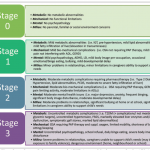kids
The Edmonton Obesity Staging System for Pediatrics
Edmonton Obesity Staging System – Pediatrics (EOSS-P) Regular readers are by now familiar with the Edmonton Obesity Staging System (EOSS), that classifies individuals with obesity based on its impact on physical, mental and functional health. Now, Stasia Hadjiyannakis and colleagues present an adaptation of EOSS for kids, published in Pediatrics and Child Health. The evidence-informed paediatric clinical obesity staging system (EOSS-P), builds on EOSS for adults and captures the severity of disease, as well as factors that complicate management, within four domains of health most commonly encountered in obesity: The EOSS-P assesses four main domains that are impacted by obesity and can impact responsiveness to weight management – metabolic, mechanical, mental, milieu: Metabolic Metabolic complications of paediatric obesity include glucose dysregulation (including type 2 …
Welcome To The International Congress on Obesity, Vancouver 2016
This weekend sees the start of the XIII International Congress on Obesity (ICO), hosted by the World Obesity Federation in partnership with the Canadian Obesity Network (CON) in Vancouver, Canada. As this year’s Congress President, together with World Obesity Federation President Dr. Walmir Coutinho, it will be our pleasure to welcome delegates from around the world to what I am certain will be a most exciting and memorable event in one of the world’s most beautiful and livable cities. The program committee, under the excellent leadership of Dr. Paul Trayhurn, has assembled a broad and stimulating program featuring the latest in obesity research ranging from basic science to prevention and management. I can also attest to the fact that the committed staff both at the …
How To Interpret Studies On Screen Time And Eating Behaviour
Much of the research on the contribution of screen time, sedentariness, food consumption and other factors comes from cross-sectional or longitudinal studies, where researchers essentially describe correlations and statistical “effect sizes”. To be at all meaningful, analyses in such studies need to be adjusted for known (or at least likely) confounders (or at least the confounders that happen to available). No matter how you turn and wind the data, such studies by definition cannot prove causality or (even less likely) predict the outcome of actual intervention studies. Nevertheless, such studies can be helpful in generating hypotheses. Thus, for example, I read with interest the recent paper by Lei Shang and colleagues from the University of Laval, Quebec, Canada, published in Preventive Medicine Reports. The researchers …
Talking to Kids About Food
What Should Children Eat? Asks this year’s Food Issue of the New York Times Sunday magazine. The issue explores how to get kids to eat more adventurously, what kids around the world eat for breakfast (not always sweetened cereal….), and more. In our heightened concern with healthy food and eating practices, looking at how our children relate to food makes sense. I add to the discussion here by reprinting an article on how to talk to kids about food—what encourages better choices, what instills too much fear?
Adolescent Girls and “Not Quite” Eating Disorders
Do you encourage or freak out if your normal weight teen wants to diet? When it comes to the thin-line of adolescent girls’ “not quite” eating disorders, parents face new challenges—even when childhood eating issues have been minimal or non-existent before. For more thoughts and guidance, check out “Thin From Within” at Psychology Today. https://www.psychologytoday.com/blog/thin-within/201411/adolescent-girls-and-not-quite-eating-disorders


